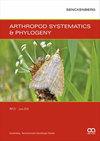Phylogeography of the Poecilimon ampliatus species group (Orthoptera: Tettigoniidae) in the context of the Pleistocene glacial cycles and the origin of the only thelytokous parthenogenetic phaneropterine bush-cricket
IF 1.8
2区 农林科学
Q2 ENTOMOLOGY
引用次数: 4
Abstract
Abstract Parthenogenetic lineages are known to rapidly colonize large areas that become available after glacial periods as parthenogenetic reproduction is beneficial over mating when the favorable season is very short. The only obligatory parthenogenetic species of the largest bush-cricket subfamily Phaneropterinae is Poecilimon intermedius. It belongs to the Anatolio-Balkan lineage Poecilimon ampliatus species group and in contrast has a remarkably broad distribution from Central Europe to China, following the pattern of geographical parthenogenesis. In this study we provide a systematic revision of the P. ampliatus group based on mitochondrial (ND2) and nuclear (ITS) phylogeny. We estimate divergence times by applying secondary calibration on the ND2 tree to test for congruence between recent splits in the group and the Pleistocene climatic oscillations. We use ecological niche modelling to analyze the ecological requirements of the parthenogenetic P. intermedius and its sexually reproducing sister species P. ampliatus. By projecting on the conditions during the Last Glacial Maximum we outline the suitable areas for both species during the glacial cycles and discuss range shifts in response to climate change. Based on all results we hypothesize that the drought-tolerant P. intermedius originated during the recent glaciations in the southwestern part of its current range and rapidly radiated in a northeastern direction. Its sister species P. ampliatus, which is adapted to higher levels of precipitation, remained in the western Balkans, where populations retreated to higher altitudes during warming.在更新世冰川旋回和唯一的单性生殖雌蝶灌木蟋蟀起源的背景下,大斑拟蛱蝶种群(直翅目:蛱蝶科)的系统地理学研究
孤雌生殖谱系在冰期后迅速占领大片地区,因为在有利季节非常短的情况下,孤雌生殖比交配更有利。在最大的丛蟋蟀亚科中,唯一必须孤雌生殖的种是中间小蟋蟀。它属于安纳托利亚-巴尔干谱系的大腹水蛭种群,相反,它在中欧到中国的分布范围非常广泛,遵循地理孤雌生殖的模式。在这项研究中,我们基于线粒体(ND2)和核(ITS)系统发育对P. ampliatus类群进行了系统的修订。我们通过对ND2树进行二次校准来估计分裂时间,以测试该组最近的分裂与更新世气候振荡之间的一致性。我们利用生态位模型分析了孤雌生殖的P. intermedius及其有性繁殖的姊妹种P. ampliatus的生态需求。通过对末次盛冰期条件的预测,我们勾勒出两个物种在冰期旋回期间的适宜区域,并讨论了响应气候变化的范围变化。基于以上结果,我们推测耐干旱的中间稻属植物起源于其现今活动范围的西南部分,并迅速向东北方向辐射。它的姐妹种,适应更高水平降水的放大疟原虫,留在了巴尔干西部,那里的种群在变暖期间撤退到更高的海拔。
本文章由计算机程序翻译,如有差异,请以英文原文为准。
求助全文
约1分钟内获得全文
求助全文
来源期刊

Arthropod Systematics & Phylogeny
Agricultural and Biological Sciences-Insect Science
CiteScore
2.50
自引率
5.60%
发文量
26
审稿时长
12 weeks
期刊介绍:
Arthropod Systematics & Phylogeny releases three times per year. Research fields covered are the taxonomy, morphology/anatomy, phylogeny (molecular or morphology-based), historical biogeography and palaeontology of arthropod taxa.
Arthropod Systematics & Phylogeny is the successor of Entomologische Abhandlungen, formerly published by the Museum of Zoology Dresden, Germany.
 求助内容:
求助内容: 应助结果提醒方式:
应助结果提醒方式:


